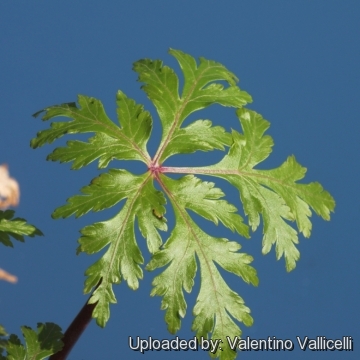




Your support is critical to our success.

Origin and Habitat: Madeira Islands Portugal (Autonomous Region)
Habitat: It’s an understory plant that grows in the evergreen forests of laurel which originally clothed Madeira. Due to the volcanic origin of the island the soil on Madeira is generally acidic.
Synonyms:
ENGLISH: Madeira cranesbill, Madeira geranium
FRENCH (Français): Géranium de Madère
Description: Geranium maderenseSN|25144]]SN|25144]] is the largest of the true geraniums species belonging to the section Anemonifolia that includes short lived perennials forming very large rosette plants with leaves divided to the base. It may form a broad dome of foliage over 1 metres in height and across. In cooler, wetter climates Geranium maderenseSN|25144]]SN|25144]] it is a monocarpic plant (almost biennial, growing in the first year and flowering the second) that flowers once on a single terminal massive head then dies. In Mediterranean climates it is occasionally a short-lived perennial, elongating its woody stem year after year until it looks quite messy.
Stem: Woody is over 50 cm tall and produces a rosette of leaves from the centre.
Leaves: Large, glossy green up to 30 (or more) cm across, rounded, divided to the base into deeply clawed lobes on long dark purple stems.
Inflorescences: It produces a lax terminal inflorescence 90 or more centimetres in diameter and 120 cm tall with hundreds, well at least a hundred, bright purplish-pink to magenta flowers that form a dome over the leaves.
Flower: Saucer-shaped, 5-petalled, up to 3,5 cm wide on sticky and hairy purple stems. Petals dark wine-coloured with darker centres and darker veins and a boss of stamens and pistil.
Blooming season: Flowering is usually initiated in winter to early spring and, in the case of mature plants, extends well into mid-summer. Flowering lasts over an extended period with new flowers opening every day as the pollinated ones collapse, shrivel and fall.
Bibliography: 1) Simon Rickard “The New Ornamental Garden” Csiro Publishing, 31/Mar/201
2) Maria Lis-Balchin “Geranium and Pelargonium: History of Nomenclature, Usage and Cultivation” CRC Press, 14/Jan/2004
3) Yeo, Peter. “Hardy Geraniums” Portland, Or: Timber Press, 2002.
4) Hephaestus Books “Articles on Geranium, Including: Geranium Cinereum, Geranium Maderense, Geranium - Magnificum, Geranium Robertianum, List of Cranesbill Species, ....” Hephaestus Books, 31/Aug/2011
5) “Plants in Getty's Central Garden” Getty Publications, 2003
6) Pat Welsh “Pat Welsh's Southern California Organic Gardening, 3rd Ed: Month by Month”
Chronicle Books, 01/Nov/2009
7) Sara Oldfield “Botanic Gardens: Modern-Day Arks” MIT Press, 30/Sep/2010
8) Schlüter, Thomas, and Martin H. Trauth. “Madeira.” Geological Atlas of A frica: With Notes on Stratigraphy, Tectonics, Economic Geolog y, Geohazards and Geosites of Each Country. Berlin: Springer, 2006. 146-147.
9) Yeo, Peter. “Two New Geranium Species Endemic to Madeira.” Boletim do Museu Municipal do Funchal 23: art. 104 (1969): 26-31.

Geranium maderense Photo by: Valentino Vallicelli
The gallery now contains thousands of pictures, however it is possible to do even more. We are, of course, seeking photos of species not yet shown in the gallery but not only that, we are also looking for better pictures than those already present. Read More...
Cultivation and Propagation: Geranium maderenseSN|25144]]SN|25144]] is a plant with great structural qualities, large and domed in its habit with rich green leaves of a distinctive shape and a magnificent head of flowers.
Soil: It like well-drained, well-composted acidic or neutral soils.
Feeding: Fertilizing this plant with an acid fertilizer such as those used for Azalea and Camellia plants may be beneficial. Give it also organic fertilizer for bloom and growth. Be cautious of over fertilizing herbaceous plants like this though, as it can make them grow too fast and they may become weak.
Transplantation: It is amenable to being transplanted, even at quite advanced stages of growth, and take perfectly happily to good loamy soils and traditional garden beds.
Exposure: It is a forest plant and prefers shade.
Temperatures: It grows well in Mediterranean climates free of heavy frosts (Hardy to about – 6° C USDA 8-9), It do not grow well in humid tropical areas.
Drought rating: Very tough.
Maintenance: It must not be cut back as it is a monocarpic plant because it flowers once then dies. Do not cut away old leaf stems or the plant will fall over. As the leaves fade, their stems bend down to support the top-heavy flower cluster.
Uses: It is an especially attractive plant under and between orchard trees or within tree plantations where there is 2-3 m clear space beneath the canopy marking it for distinction in Mediterranean garden. It is particularly good in coastal gardens where it enjoys the extra humidity and frost-tree conditions.
Propagation: The mother plant will die after flowering, but pups will usually form at the base and it self-seeds with seedlings frequently spring up nearby. It seems to prefer tight crannies and crevices when it self-sows, and seedlings can be left in situ to replace older plants.
| Your Actions | |
|---|---|
| Back to Geranium index | |
| Back to Geraniaceae index | |
 |
Back to Succulents Encyclopedia index |
Privacy stantement - Terms and conditions - How to cite - About us - Feedback - Donate




